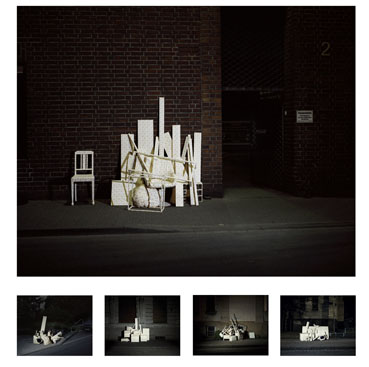| Agnieszka Szreder |
Alexis Hubig | Anaide Chirinian | Annette Jonak | Arszyn & Emiter | ||
| Björn Jung |
Emilie Zanon &Franck Cassar | Gregor Vanerian | Marc Sauter | Wojciech Kosma | ||
| Special Jury Votes: |
Maja Linke | Rolf Pilarsky | ||||
Anette Jonak Born 1976 in Frankfurt /Main Germany. selected exhibitions
Who or what is Europe? Considering the European Union, the vertical segregation of European States in for example temporarily so called "Core Europe", "New Member States" and! "Candidate States" (but as well "Eurozone", "Nato-Membership") seems to prospect a clear hierarchy which provides the direction supposed to be aspired by Candidate States (and candidates aiming to be Candidate State…). Borders produce an "outside" from where - in case of the enlargement of the European Union - countries like Rumania, Bulgaria or Turkey run for membership. This one-dimensional view of the duality "in front of and behind the border" hardly fits reality: the social, economic and cultural differences between and also within the 25 Member-States are huge. Moreover, cross-Europe (which appears to be easily definable in geographic terms ) manifold economic, political as well as social borderlines –not only referring to the EU, the Schengen Agreement etc.- are placed. Even in the so-called "Core Europe" a "social outside" exists, are people economically as socially excluded, marginalised. Not only does the one-dimensional duality alo! ng geographic borders not correspond with reality on the level of states, but even more not on the individual ones. If you are trying to describe the situation which is asked and desired when entering the European Union, instead of finding "hard facts" there is a huge smorgasbord of political and cultural aspects as well as those of human rights let alone a variety of individual wishes, visions, hopes, fears and prejudices. On the designated expedition as well as in the following working environment I would like to follow the question what importance the borders mentioned above finally retain. I can imagine Polaroid-pictures and Audiofiles as work-material. In most parts of Europe Polaroid-pictures connected with their very special aesthetics probably provoke a collective memory of former times, family-albums and, depending on the country, of a far or even very far backdated documentation. Especially the reduction of states outside the EU to the status of "not yet" which happens again and again, masking the near indiv! idual as well as common European history seems to me an interesting aspect I would like to work on by using polaroid-pictures. Working with this kind of material, by giving attention to all its properties like distortion of colours and sharpness and by pointing it out by scanning and by blowing up the used material, offers the opportunity of a queer twist in the frame of time. The documentation of the current external as well as internal space of the European Union is transferred to an artificial past, which at the same time suggests (with pictures which in a way show a historicised present) to the spectator the idea of a visionary future. Through the technical aesthetics of a picture language known from everyone's private photo album, a link with personal memories and experiences is established: in this case the collective memory is based on individual memories. These personal experiences are the basis of a collage of audiorecordings prese! nted beside the pictures via headset, composed of short cuts of interviews. As for the interviews, I would be particularly interested in the attitudes, points of view, wishes and fears of people, inside or outside the EU, who do not fit the stereotype of a "EU-citizen" or "non-EU-citizen". This, for example, could be people who have been living in the EU for a long time without entering a legal status, people who moved from the old member states to the new ones without an official legitimation to search and find (or not...) a personal perspective or people who might have moved to the periphery of the EU. The fact that the time, the place and the authors of the audio-files are not mentioned and the former described selection of the interview-partners helps to gather a collection of opinions which consciously ignores or questions borders. Together with the photographs the figured work opens a space of associations for the spectator which conclude in one hand a "european" review, on the other ! hand a spot -independant from geographical and political borders- to the future.
|
||||||
